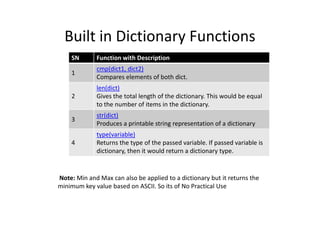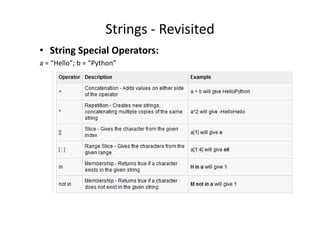Python - Lecture 4
- 1. Python Lecture 4Lecture 4 - Ravi Kiran Khareedi
- 2. Lists - Revisited • Accessing Values in List list1 = ['physics', 'chemistry', 1997, 2000] list2 = [1, 2, 3, 4, 5, 6, 7 ]list2 = [1, 2, 3, 4, 5, 6, 7 ] print "list1[0]: ", list1[0] print "list2[1:5]: ", list2[1:5]
- 3. Lists - Revisited • Updating Values in List list = ['physics', 'chemistry', 1997, 2000]; print "Value available at index 2 : "print "Value available at index 2 : " print list[2]; list[2] = 2001; print "New value available at index 2 : " print list[2];
- 4. Lists – Revisted • Deleting the entire list Testlist = [‘a’, ’b’, ’c’] print Testlistprint Testlist del Testlist print Testlist
- 6. Built in Functions SN Function with Description 1 cmp(list1, list2) Compares elements of both lists. 2 len(list) Gives the total length of the list. 3 max(list) Returns item from the list with max value. 4 min(list) Returns item from the list with min value. Output of cmp: cmp(list1, list2) - returns 0 if list1 = list2 returns 1 if list1 > list2 return -1 if list1 < list2 Others functions are self explanatory. (These built in functions are supported by python for any kind of data structure not just lists) 4 Returns item from the list with min value. 5 list(seq) Converts a tuple into list. 6 type(obj) Returns the type of the object
- 7. More List Methods list.append(obj) - Appends object obj to list list.count(obj) - Returns count of how many times obj occurs in list list.extend(seq) - Appends the contents of seq to list list.index(obj) - Returns the lowest index in list that obj appears list.insert(index,obj) - Inserts object obj into list at offset indexlist.insert(index,obj) - Inserts object obj into list at offset index list.pop(obj = list[-1]) - Removes and returns last object or obj from list list.remove(obj) - Removes object obj from list list.reverse() - Reverses objects of list in place list.sort() - Sorts objects of list, use compare func if given
- 8. Tuples - Revisited • Accessing Values in Tuples tup1 = ('physics', 'chemistry', 1997, 2000); tup2 = (1, 2, 3, 4, 5, 6, 7 ); print "tup1[0]: ", tup1[0]print "tup1[0]: ", tup1[0] print "tup2[1:5]: ", tup2[1:5]
- 9. Tuples - Revisited • Updating Values in Tuples Tuples are immutable so we cannot update them or change values of tuple elements. But we able to take portions of an existing tuples to create a new tuples.new tuples. Ex: tup1 = (12, 34.56); tup2 = ('abc', 'xyz'); tup3 = tup1 + tup2; print tup3;
- 10. Tuples - Revisted • Deleting Elements from tuples – Not possible as its immutable. – But the entire tuples can be deleted. Ex:Ex: tup = ('physics', 'chemistry', 1997, 2000); print tup; del tup; print "After deleting tup " print tup;
- 11. More Tuple operations Python Expression Results Description len((1, 2, 3)) 3 Length (1, 2, 3) + (4, 5, 6) (1, 2, 3, 4, 5, 6) Concatenation ('Hi!‘,) * 4 ('Hi!', 'Hi!', 'Hi!', 'Hi!') Repetition 3 in (1, 2, 3) True Membership for x in (1, 2, 3): print x, 1 2 3 Iteration
- 12. Built in Tuple functions SN Function with Description 1 cmp(tuple1, tuple2) Compares elements of both tuples. 2 len(tuple) Gives the total length of the tuple. 3 max(tuple) Returns item from the tuple with max value. 3 Returns item from the tuple with max value. 4 min(tuple) Returns item from the tuple with min value. 5 tuple(seq) Converts a list into tuple. 6 type(obj) Returns the type of the object
- 13. Dictionary – Revisted • Accessing and Updating – Already seen • Deleting Dictionary Elements – Del dict(‘Key’) # remove the element with key – dict.clear() – del dict Ex: dict = {'Name': 'Zara', 'Age': 7, 'Class': 'First'};dict = {'Name': 'Zara', 'Age': 7, 'Class': 'First'}; print dict['Name']; dict.clear(); print dict; dict['Age'] = 25 print dict del dict dict['Name'] = “Muller“ TRY IT: dict = {'Name': 'Zara', 'Age': 7, 'Name': 'Manni'}; # Key is not unique print "dict['Name']: ", dict['Name'];
- 14. Built in Dictionary Functions SN Function with Description 1 cmp(dict1, dict2) Compares elements of both dict. 2 len(dict) Gives the total length of the dictionary. This would be equal to the number of items in the dictionary. str(dict) 3 str(dict) Produces a printable string representation of a dictionary 4 type(variable) Returns the type of the passed variable. If passed variable is dictionary, then it would return a dictionary type. Note: Min and Max can also be applied to a dictionary but it returns the minimum key value based on ASCII. So its of No Practical Use
- 15. More Dictionary Methods SN Methods with Description 1 dict.clear() Removes all elements of dictionary dict 2 dict.copy() Returns a shallow copy of dictionary dict 4 dict.get(key, default=None) For key key, returns value or default if key not in dictionary 5 dict.has_key(key) Returns true if key in dictionary dict, false otherwise 6 dict.items() Returns a list of dict's (key, value) tuple pairs 7 dict.keys() Returns list of dictionary dict's keys 9 dict.update(dict2) Adds dictionary dict2's key-values pairs to dict 10 dict.values() Returns list of dictionary dict's values
- 16. Strings - Revisited • String Special Operators: a = “Hello”; b = “Python”


![Lists - Revisited
• Accessing Values in List
list1 = ['physics', 'chemistry', 1997, 2000]
list2 = [1, 2, 3, 4, 5, 6, 7 ]list2 = [1, 2, 3, 4, 5, 6, 7 ]
print "list1[0]: ", list1[0]
print "list2[1:5]: ", list2[1:5]](https://image.slidesharecdn.com/lecture4-140822163643-phpapp02/85/Python-Lecture-4-2-320.jpg)
![Lists - Revisited
• Updating Values in List
list = ['physics', 'chemistry', 1997, 2000];
print "Value available at index 2 : "print "Value available at index 2 : "
print list[2];
list[2] = 2001;
print "New value available at index 2 : "
print list[2];](https://image.slidesharecdn.com/lecture4-140822163643-phpapp02/85/Python-Lecture-4-3-320.jpg)
![Lists – Revisted
• Deleting the entire list
Testlist = [‘a’, ’b’, ’c’]
print Testlistprint Testlist
del Testlist
print Testlist](https://image.slidesharecdn.com/lecture4-140822163643-phpapp02/85/Python-Lecture-4-4-320.jpg)


![More List Methods
list.append(obj) - Appends object obj to list
list.count(obj) - Returns count of how many times obj occurs in list
list.extend(seq) - Appends the contents of seq to list
list.index(obj) - Returns the lowest index in list that obj appears
list.insert(index,obj) - Inserts object obj into list at offset indexlist.insert(index,obj) - Inserts object obj into list at offset index
list.pop(obj = list[-1]) - Removes and returns last object or obj from list
list.remove(obj) - Removes object obj from list
list.reverse() - Reverses objects of list in place
list.sort() - Sorts objects of list, use compare func if given](https://image.slidesharecdn.com/lecture4-140822163643-phpapp02/85/Python-Lecture-4-7-320.jpg)
![Tuples - Revisited
• Accessing Values in Tuples
tup1 = ('physics', 'chemistry', 1997, 2000);
tup2 = (1, 2, 3, 4, 5, 6, 7 );
print "tup1[0]: ", tup1[0]print "tup1[0]: ", tup1[0]
print "tup2[1:5]: ", tup2[1:5]](https://image.slidesharecdn.com/lecture4-140822163643-phpapp02/85/Python-Lecture-4-8-320.jpg)




![Dictionary – Revisted
• Accessing and Updating – Already seen
• Deleting Dictionary Elements
– Del dict(‘Key’) # remove the element with key
– dict.clear()
– del dict
Ex:
dict = {'Name': 'Zara', 'Age': 7, 'Class': 'First'};dict = {'Name': 'Zara', 'Age': 7, 'Class': 'First'};
print dict['Name'];
dict.clear();
print dict;
dict['Age'] = 25
print dict
del dict
dict['Name'] = “Muller“
TRY IT:
dict = {'Name': 'Zara', 'Age': 7, 'Name': 'Manni'}; # Key is not unique
print "dict['Name']: ", dict['Name'];](https://image.slidesharecdn.com/lecture4-140822163643-phpapp02/85/Python-Lecture-4-13-320.jpg)



